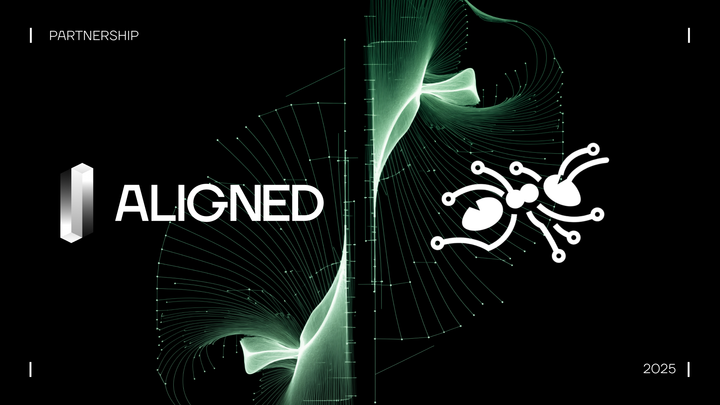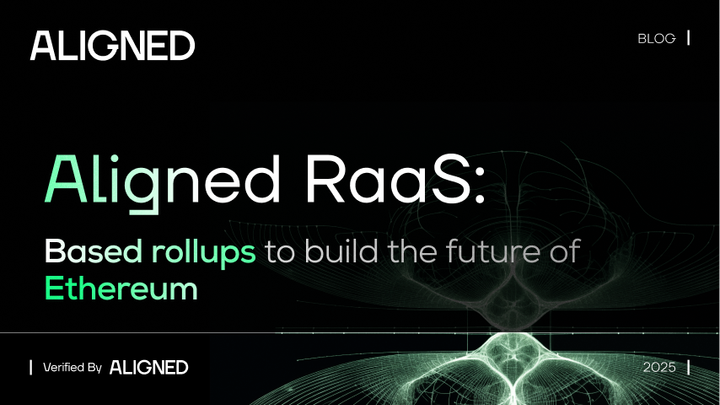Aligned’s Proof Verification Layer and Proof Aggregation Service: two options for making ZK on Ethereum fast, affordable, and scalable.
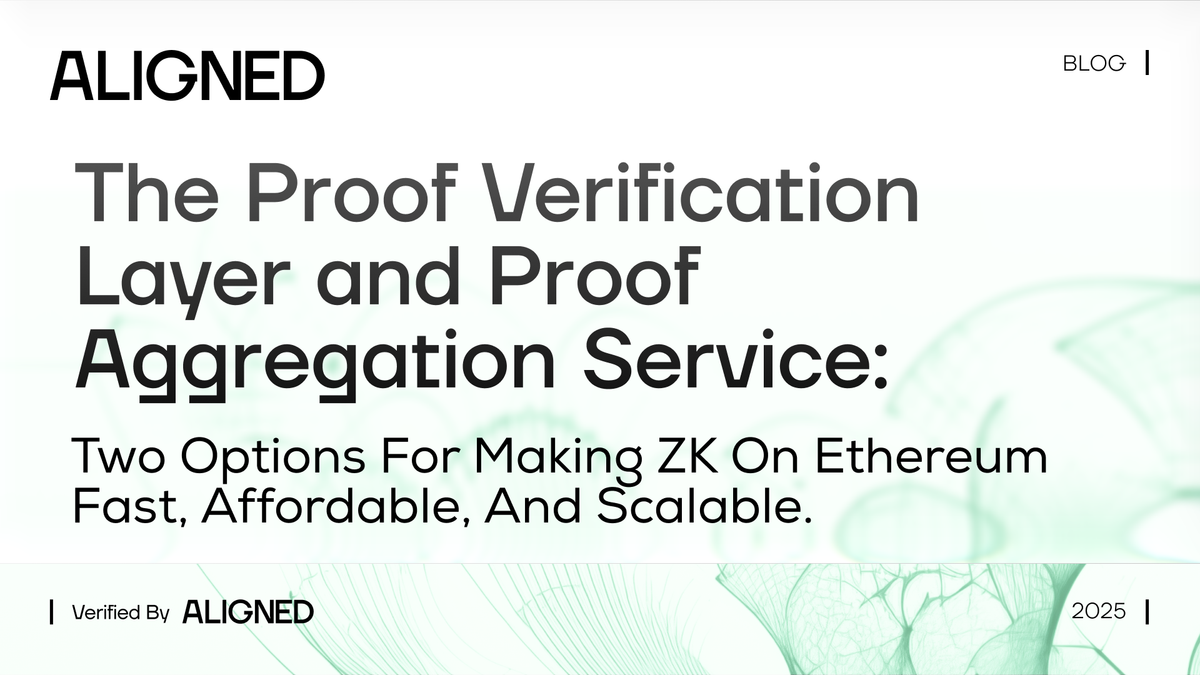
Zero-knowledge (ZK) proofs are at the heart of Ethereum’s future. It’s the technology chosen to scale the EVM by 1000x without sacrificing decentralization, and is also being used to improve the efficiency and security of Ethereum’s consensus layer (detailed in the lean roadmap).
1 gigagas/sec (10K TPS) on Ethereum L1 with zkVMs
— Justin Drake (@drakefjustin) April 26, 2025
no compromises:
→ consumer hardware (zkVMs)
→ home internet (DAS)
→ censorship resistance (FOCIL)
→ 100% uptime (client diversity)
→ 8K consensus nodes
Built for internet finance. Believe in something real.
As ZK is adopted at every level of the stack, from the L1 to the application layer, more and more proofs are being generated. Proofs must be verified, and as the most decentralized and censorship-resistant root of trust in the world, Ethereum is where this needs to happen.
But there’s a problem: the EVM wasn’t designed to verify hundreds of ZK proofs in a single block, and new solutions are needed to support a future with more zk-rollups and many other applications.
Verifying a single Groth16 SNARK proof uses at least ~250K gas while STARK proof verification can exceed a million gas. This means Ethereum can only verify up to 15 proofs per second at its 45M gas limit, greatly limiting the number of applications or rollups that can settle ZK proofs to Ethereum (not to mention prohibitively high gas costs that prevent many use cases).
Aligned solves this bottleneck with two approaches, giving developers flexibility in reducing verification costs depending on their needs:
Our first product, the Proof Verification Layer (previously called Fast Mode) is already live on mainnet and is secured by $11B USD worth of restaked ETH. It is an Actively Validated Service (AVS) built on EigenLayer that makes proof verification cheap, fast, and scalable by offloading verification to a decentralized, global network of 52 operators.
These restaked validators (operators) run verification code natively and report the result back to Ethereum with aggregated BLS signatures. By running verifiers on bare metal rather than in the EVM, the network can verify thousands of proofs per second and reduce per‑proof verification costs by 90-99% (more savings for more expensive proofs like STARKs).
Proofs that can wait for stronger security or need on‑chain finality can be verified through the Proof Aggregation Service. This uses recursion to combine (or “compress”) multiple proofs into a single proof which is directly verified on Ethereum.
Proof Verification Layer
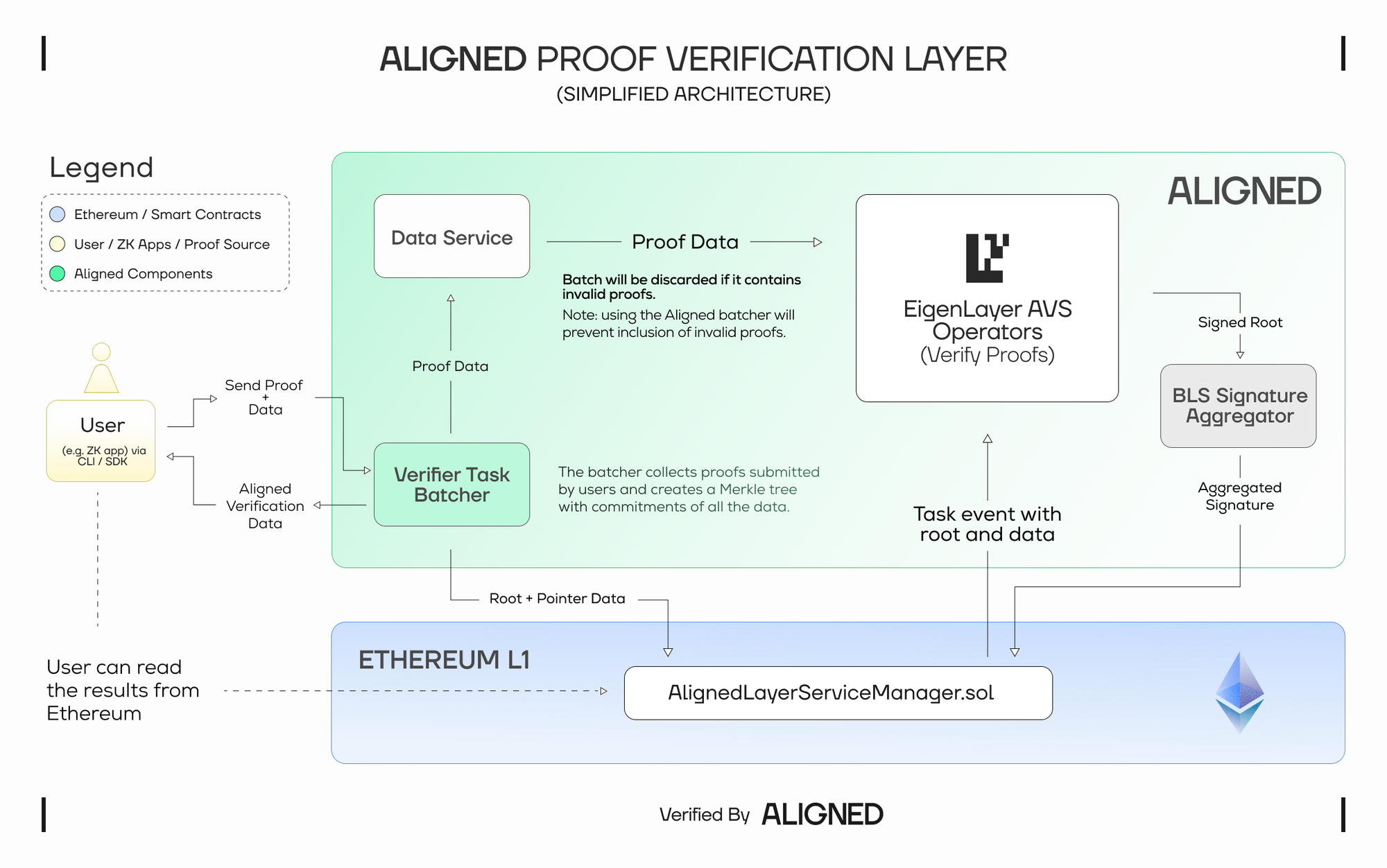
- Mainnet status – Live on Ethereum since December 2024. The mainnet beta is secured by 52 operators and nearly 3 million in restaked ETH (~$11B USD). Upcoming upgrades include improvements to the payment system, SDK, and L2 settlement.
- Throughput – The current mainnet beta version can verify around 200 proofs per second, with tests demonstrating over 4000 verifications per second (and capacity for much higher). Ethereum is limited to a maximum of 180 proofs verified per block; Aligned increases verification throughput to 30,000 proofs per block while still settling results to Ethereum.
- Cost – Proofs are verified off‑chain and only an aggregated BLS signature is submitted to Ethereum for verification (~113k gas), with additional gas costs involved in the process, a batch with a single proof (of any type) will cost ~350k gas. Because the per-proof cost of verification is amortized across all proofs in the batch, a batch of 20 proofs (of any type!) will currently cost ~40k gas per proof. This saves at least 84% on gas fees for the same number of proofs if using Groth16 as a benchmark (the cheapest proof to verify on Ethereum).
- Latency & finality – Proof verification is fast (milliseconds), and could in the future return a signed result as soon as two‑thirds of the operators have verified and signed. Currently, results can be read from the smart contract on Ethereum as early as after one block, but to save costs the Verification Layer will wait for a few blocks to batch more proofs. This “soft finality” inherits the security of EigenLayer’s restaking network, which is derived from Ethereum via restaked ETH delegated to operators.
- Supported proof systems – We currently support Risc0, SP1, Gnark (Groth16 and Plonk), and Circom (Groth16) verifiers. Because code runs on bare metal, the Proof Verification Layer can handle proof systems that are prohibitively expensive in the EVM, such as Kimchi or Binius. Adding new proof systems is straightforward, meaning Aligned can help nearly any current or future proof system be economically used with Ethereum.
Proof Aggregation Service

- Testnet status – Live on the Ethereum Holesky testnet. Developers currently submit proofs via the Proof Verification Layer testnet deployment; the service batches compatible proofs, produces one recursive proof and posts it to Ethereum. Only proofs verified by the Proof Verification Layer are eligible for aggregation, but developers will have the option to use one or the other (or both) when it goes into production on mainnet.
- Throughput & cost – Each aggregated proof costs ~300 K gas to verify . The gas cost is shared across all proofs in the batch, so per‑proof cost falls as the batch grows. Throughput is lower than the Proof Verification Layer AVS because generating recursive proofs takes time.
- Latency & finality – Aggregation introduces additional latency (minutes for recursive proving, rather than milliseconds). In return, the aggregated proof is verified directly on Ethereum, giving “hard finality” equivalent to full L1 security. Larger batches of proofs take more time.
- Supported proof systems – The Proof Aggregation Service currently supports Risc0 and SP1 proofs in this testnet release. Upcoming improvements include adding more proof systems, improving the payment system for higher throughput, and refining SDKs so developers can easily choose between the Proof Verification Layer and Aggregation Service.
Feature comparison
Together, the Proof Verification Layer and Proof Aggregation Service make up Aligned’s ZK Verification Layer. The two modes give developers options for reducing verification costs depending on their security, throughput, and cost needs. For very high proof volumes, the Proof Verification Layer AVS offers the highest gas savings. For applications that need the full security of Ethereum (e.g. ZK-rollups) but can accept higher latency, the Proof Aggregation Service is a better fit.
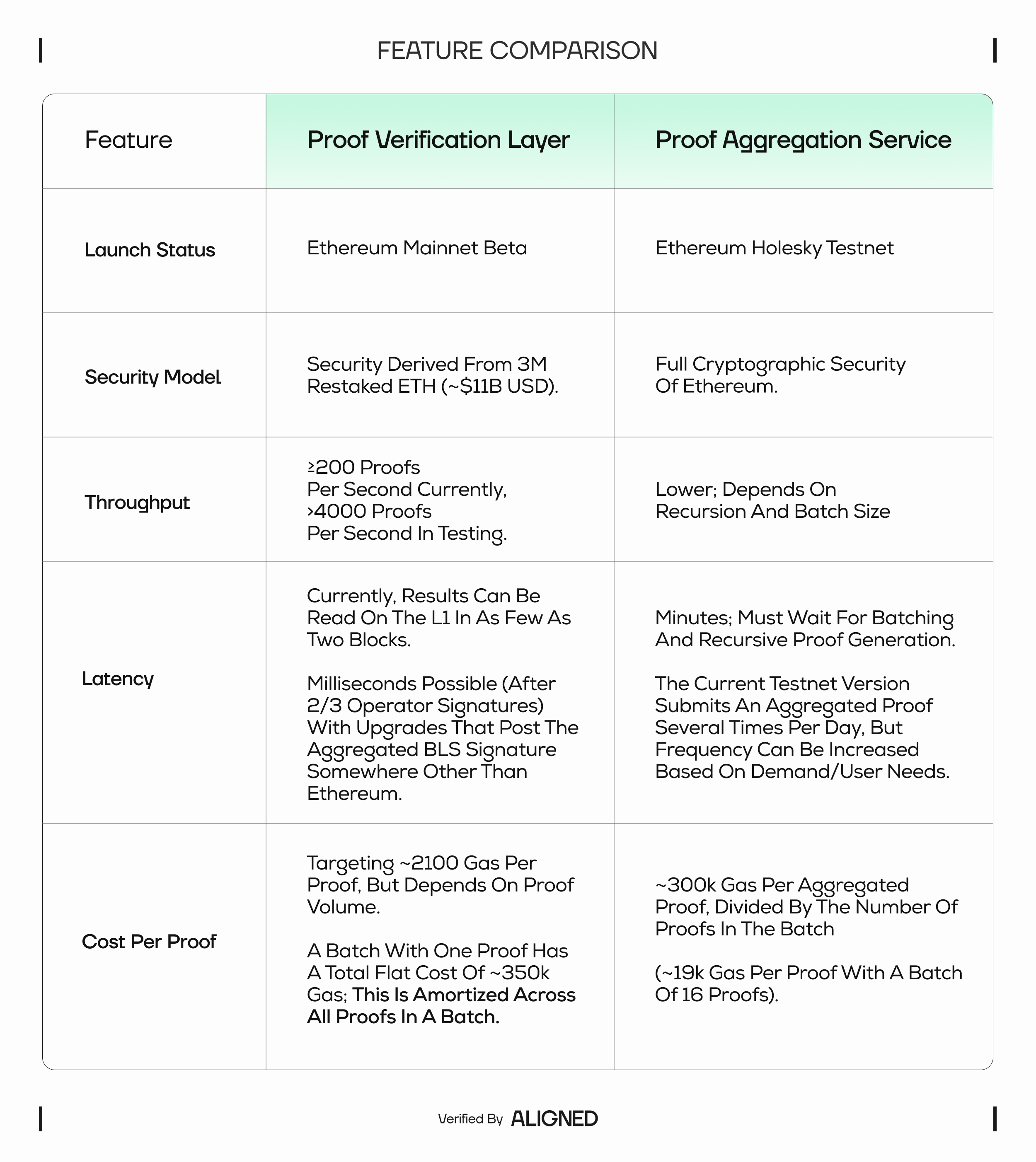
When to use which service?
- Applications needing instant or near‑instant confirmations – micro payments, onchain gaming, or identity applications that need low latency or the lowest per‑proof costs to scale with a high volume of proofs being generated. Because operators sign results off‑chain, projects can settle quickly, and the result can be referenced by L2s or other chains without waiting for Ethereum finality.
- Rollups and data‑availability layers – Rollups that aim to compress many proofs and inherit full Ethereum security are better suited to the Aggregation Service. Since multiple proofs are recursively aggregated and verified in a single transaction, rollups or DA layers can amortise on‑chain verification costs.
- Bridging and settlement layers – Fast cross‑chain bridges, intent‑based protocols or ZK coprocessors may combine both modes: Verification Layer for fast soft‑finality and Aggregation Service for eventual hard‑finality checkpoints, giving users the option to exit with Ethereum‑level security.
- Verifiable AI – The rapid acceleration of AI adoption means that AI is increasingly being trusted with critical decisions. Proving AI model inference lets us verify that they’re running as intended, and our ZK verification layer allows this to be done at the scale we expect as demand increases. ZK identity applications will also become increasingly important as the need to distinguish models from humans. Learn more about why AI need ZK and Ethereum in this article.
- zkTLS – This technology connects web2 data to web3 applications by letting users generate proofs to verify the authenticity of their off-chain data. Using Aligned to verify these proofs on Ethereum allows data like bank balances or social network data to be used onchain while preserving privacy and minimizing trust, without high verification gas costs being a bottleneck for users or scaling. Either service could be a good fit depending on cost, throughput, latency, or security needs.
What’s next?
For the Proof Verification Layer, we are working on continually improving the stability and resiliency of the batcher, improving its payment system to unlock higher throughput, and refining the SDK for easier integration. Longer-term upgrades include L2 settlement so verification results can be read on L2s directly. With 52 operators and 3 million restaked ETH securing the decentralized network, we plan to scale toward tens of thousands of proofs per second and broaden support for additional proof systems.
The Proof Aggregation Service will be deployed to Ethereum mainnet later this year after it supports a wider set of proofs, offers better payment rails, is integrated seamlessly with the SDK, and completes security audits. It is being vertically integrated with our upcoming RaaS platform (built on the Ethrex stack) to enable cheap and secure based ZK-rollups for everyone.
We share weekly engineering updates on our blog and during our weekly Alignment Session streams (held on X every Monday!)
Why it matters
ZK proofs underpin privacy, blockchain scaling via rollups, and secure off‑chain computation. Verifying those proofs on Ethereum natively is slow and expensive. Aligned’s ZK verification layer offers two complementary ways to verify ZK proofs: a low‑latency fast mode secured by restaking (the Proof Verification Layer AVS), and an aggregation mode with the full security of Ethereum (the Proof Aggregation Service). Together, they lower verification gas costs by up to 99%, raise throughput from ~10 proofs per second on Ethereum to thousands, and make advanced ZK applications economically viable.
If you’re building anything with ZK on Ethereum, we’d love to chat and help you bring your product to market faster and at lower cost.
Additional resources
Stay tuned: 🐦 Twitter | 🗨️ Telegram | 👾 Discord | 🌐 Website | 📝 Manifesto

